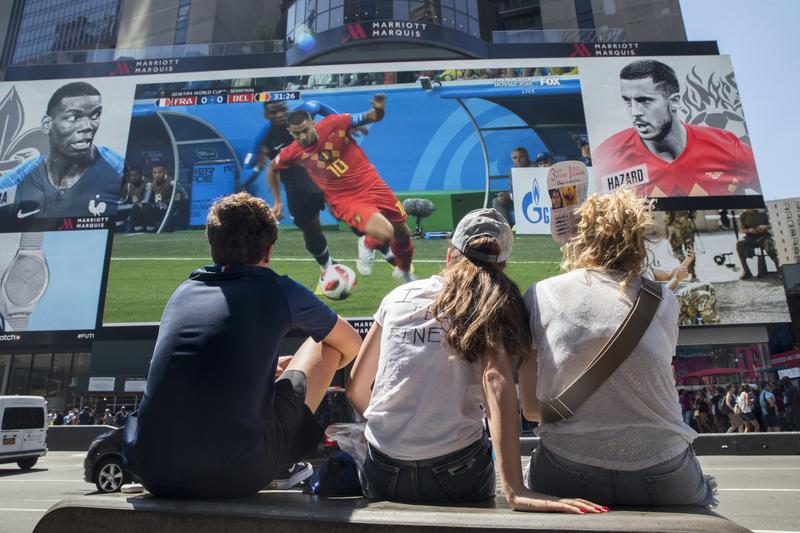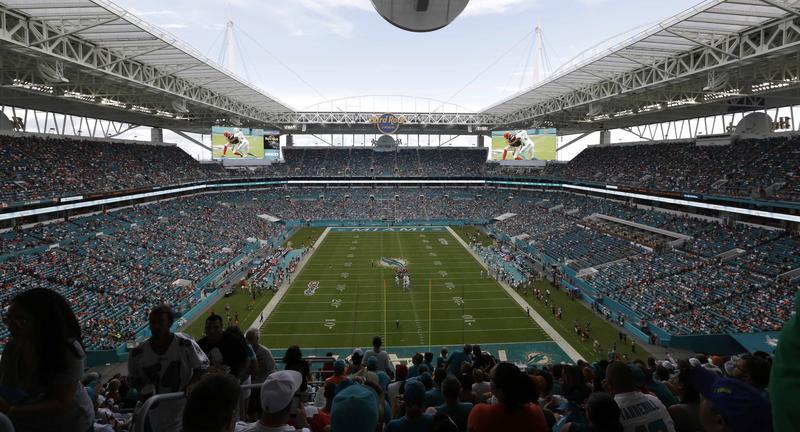 French soccer fans watch France play Belgium in a World Cup semifinal soccer game on a gigantic screen in New York's Times Square, on July 10, 2018. (MARY ALTAFFER, FILE / AP)
French soccer fans watch France play Belgium in a World Cup semifinal soccer game on a gigantic screen in New York's Times Square, on July 10, 2018. (MARY ALTAFFER, FILE / AP)
NEW YORK-As FIFA prepares to announce the 2026 World Cup sites-and make high-profile cuts-Alan Rothenberg thought back to when stadiums were picked for the 1994 tournament he headed in the United States.
"They gave the rights to the host country, and the host country basically ran the whole thing," he said. "Here, everything is done in-house by FIFA. So it's been a really long and arduous process. The terms have been incredibly difficult for cities to cope with."
Seventeen stadiums in 16 areas remained in contention to be among 10-12 selected from the US for the tournament, which will be co-hosted with Mexico and Canada. The US will host 60 of the 80 games under FIFA's plan, including all from the quarterfinals on, and there was little doubt over the venues for 10 games each in the other nations.
Last time, the nine US stadiums were announced during a Waldorf-Astoria news conference 816 days before the opener. This time, the decisions will be revealed by FIFA in a Fox television studio 1,456 days before the likely start.
In handicapping the bidders, there appeared to be several tiers:
Locks: AT&T Stadium in Arlington, Texas, and Met Life Stadium in East Rutherford, New Jersey, along with SoFi Stadium in Inglewood or the Rose Bowl in Pasadena, California.
In the hunt: Mercedes-Benz Stadium in Atlanta; M&T Bank Stadium in Baltimore; Gillette Stadium in Foxborough, Massachusetts; NRG Stadium in Houston; Arrowhead Stadium in Kansas City, Missouri; Hard Rock Stadium in Miami Gardens, Florida; Nissan Stadium in Nashville, Tennessee; Lincoln Financial Field in Philadelphia; Levi's Stadium in Santa Clara, California; and Lumen Field in Seattle.
Least likely: Paul Brown Stadium in Cincinnati; Empower Field at Mile High in Denver; and Camping World Stadium in Orlando, Florida.
In the other countries: Mexico City's Estadio Azteca, which hosted the 1970 and 1986 finals and will become the first stadium to feature in three World Cups; Guadalajara's Estadio Akron; Monterrey's Estadio BBVA; Toronto's BMO Field and Vancouver, British Columbia's BC Place. Commonwealth Stadium in Edmonton, Alberta, was expected to be dropped.
"This country has even more than 17 cities capable of hosting the World Cup, and it will be a pity for those that miss out," said Telemundo's Andres Cantor, who has broadcast the tournament since 1990 and will co-host the announcement. "But I don't think it's going to take away from the desire of soccer fans to attend the game, wherever their country lands in 2026."
 The US stadiums that will stage games at the 2026 World Cup, which will also be hosted by Canada and Mexico, were due to be announced on Thursday (Friday Beijing time). (PHOTO / AP)
The US stadiums that will stage games at the 2026 World Cup, which will also be hosted by Canada and Mexico, were due to be announced on Thursday (Friday Beijing time). (PHOTO / AP)
Rothenberg said the decision remained uncertain in the final week between SoFi, which may need pricey renovations to create a wider field, and the Rose Bowl.
"Even to this moment, there are calls going on all day long trying to sort it out," he said Tuesday.
"There will be discussions between the LA host committee and FIFA right up almost to the moment of the announcement. The costs of LA are a huge part of the difficulty."
Just two of the contending stadiums hosted games in 1994, the Rose Bowl joined by Orlando. Dozens of training complexes have been built for MLS teams, creating a far better infrastructure than at the first World Cup in the US, when Italy worked out at The Pingry School in Basking Ridge, New Jersey, and the US practiced ahead of its opener on a wind-swept field at Oakland University in Rochester, Michigan.
"It's completely different from the standpoint that in a lot of these cities there's a base of fans that have been sort of built up because of MLS," said Tony Meola, the US starting goalkeeper at that'94 Cup.
"We know Los Angeles and New York and Miami always had soccer fans, and they weren't necessarily American soccer fans, but they were fans of some teams around the world. I think we've got just a little bit more of a fever for the game. From a fan's perspective, the infrastructure in the cities is so much more developed. And tickets will never be a problem in our country if we host the World Cup every four years."
All US stadiums forecast capacities of 60,000 or larger. Three have retractable roofs and one a fixed roof. Ten have artificial turf but would switch to temporary grass.
This will be the first 48-nation World Cup, up from the 32-team format used since 1998. In a tournament likely to run from June 11 to July 12, but possibly start and end a week later, there will be 16 groups of three nations. Each team will play two first-round games instead of three as part of an awkward arrangement in which one nation in each group opens against an opponent who will have already played. The top two in each group advance to a 32-nation knockout bracket.
Revenue has skyrocketed: The 1994 Cup drew a record 3.59 million fans and grossed $580 million, which produced a profit of $133.25 million for FIFA and $50 million for the US organizing committee. FIFA said the 2018 World Cup in Russia produced $5.357 billion in revenue over the four-year cycle and a $3.533 billion surplus.
FIFA requires bidders to obtain "a limited tax exemption" for FIFA, teams and other entities involved, and the Missouri Legislature last month approved a sales tax exemption for June and July 2026. Chicago dropped out in 2018 over FIFA's demands.
Rothenberg anticipates many of the US states and cities will refuse to comply.
"I think that's a fair assumption in most of the jurisdictions. Some of them, they may just build it into the stadium price and other things, but getting an actual waiver may be difficult," he said. "Ultimately, it just means another cost that the host committee, host city, is going to be responsible for."


